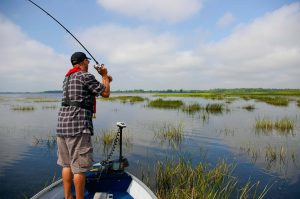Trolling for bass from a boat is a highly effective fishing technique that allows anglers to cover large areas of water and locate fish that are spread out. By mastering the art of trolling, you can increase your chances of landing trophy bass. Here’s a comprehensive guide on how to troll for bass in a boat.
1. Selecting the Right Equipment
- Trolling Rods and Reels: Use medium to heavy-action rods and reels with a smooth drag system. Trolling rods are typically longer and more flexible to handle the constant tension of trolling.
- Fishing Line: Opt for braided line or monofilament with a strength of 10-20 pounds. Braided line offers better sensitivity and strength, while monofilament provides more stretch.
- Lures and Baits: Choose lures that mimic the natural prey of bass, such as crankbaits, spinnerbaits, and swimbaits. Colors should match the water conditions, with natural colors for clear water and brighter colors for murky water.
2. Boat Setup and Speed
- Boat Speed: Maintain a steady trolling speed of 2-4 mph. Use a GPS or fishfinder to monitor your speed and make adjustments based on the behavior of the fish and the type of lure you are using.
- Rod Holders: Install rod holders on your boat to keep your rods secure and at the right angle for trolling. Rod holders also free up your hands to control the boat and monitor other equipment.
- Depth Control: Use a downrigger or lead core line to control the depth of your lures. Adjust the depth based on the water temperature, time of day, and where the bass are likely to be feeding.
3. Finding Bass
- Electronics: Utilize fishfinders and sonar to locate schools of bass and structure such as drop-offs, submerged trees, and weed beds where bass are likely to be hiding.
- Seasonal Patterns: Understand the seasonal movements of bass. In spring, bass are often found in shallow waters for spawning. In summer, they move to deeper, cooler waters. Fall brings them back to shallow areas to feed, and in winter, they seek deeper, stable water temperatures.

4. Trolling Techniques
- Zigzag Pattern: Troll in a zigzag pattern to cover more water and present your lures from different angles. This technique can trigger strikes from bass that are following your lure.
- Vary Your Speed: Occasionally change your trolling speed to mimic the erratic movement of baitfish. Speeding up or slowing down can entice bass to strike.
- Multiple Rods: Use multiple rods with different lures and depths to increase your chances of finding what the bass are biting. Be mindful of local regulations on the number of rods you can use.
5. Lure Presentation
- Matching the Hatch: Use lures that resemble the local baitfish in size, shape, and color. Matching the hatch increases the likelihood of bass striking your lure.
- Lure Depth: Ensure your lures are running at the correct depth. Bass often suspend at specific depths based on water temperature and available cover.
- Retrieve Techniques: Experiment with different retrieve techniques, such as a steady retrieve, stop-and-go, or jerking motion to see what triggers the most strikes.
6. Setting the Hook and Landing Bass
- Hook Setting: When you get a strike, set the hook firmly but smoothly to avoid pulling the lure out of the bass’s mouth. Keep the line tight to prevent the fish from shaking the hook.
- Fighting the Fish: Use a steady and controlled approach to reel in the bass. Avoid high-sticking (lifting the rod too high) as it can lead to broken rods or lost fish.
- Landing the Bass: Use a landing net to secure the bass when it gets close to the boat. A net helps reduce stress on the fish and increases your chances of successfully landing it.
Trolling for bass in a boat is an exciting and effective way to catch these elusive fish. By selecting the right equipment, understanding bass behavior, and mastering trolling techniques, you can increase your success rate and enjoy a productive day on the water. Whether you’re a seasoned angler or a beginner, trolling offers a dynamic and rewarding fishing experience.
Image: AnglerWise





